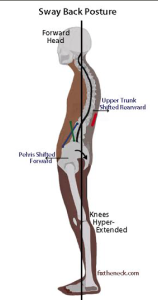 Last time we looked at the importance of an aligned spine and good posture. So, what are the other types of common deviations from this optimal position?
Last time we looked at the importance of an aligned spine and good posture. So, what are the other types of common deviations from this optimal position?
Do I remind you to push your hips back in class? If so, you may have developed a Swayback posture. In a swayback posture the hips fall forward of the mid line. So, instead of the plumb line falling from the hip to the ankle it would fall over the toes or further forward! The shape of the spine does not appear to change but it puts the body into a constant backwards bend.
In terms of how it influences the body, it causes the muscles at the front of the body to lengthen and weaken. It’s a bit of a ‘lazy’ posture and also means that the muscles at the back of the body don’t lengthen but they also become weakened especially the buttocks.
So, in a swayback posture the muscles are weakened at the front and back of the pelvis. This is the most important area for support of and movement of the body. So, what could the long term effects of this posture on the body be? Premature wear and tear of the hip sockets and lower spine due to compression of the joints because they are not being supported by the muscles. The upper neck may also experience wear and tear issues as the body will try to bring the head forward to balance out the backwards bend. Also, issues in eth feet e.g. plantar fasciitis, bunions, arthritis, may develop because the small joints of the feet are taking the weight of the body rather than the heel which is designed to take the impact of movement.
Resolving to this posture type can help to alleviate the issues above and it’s the easiest to do! All you have to do is commit to standing tall.

Recent Comments